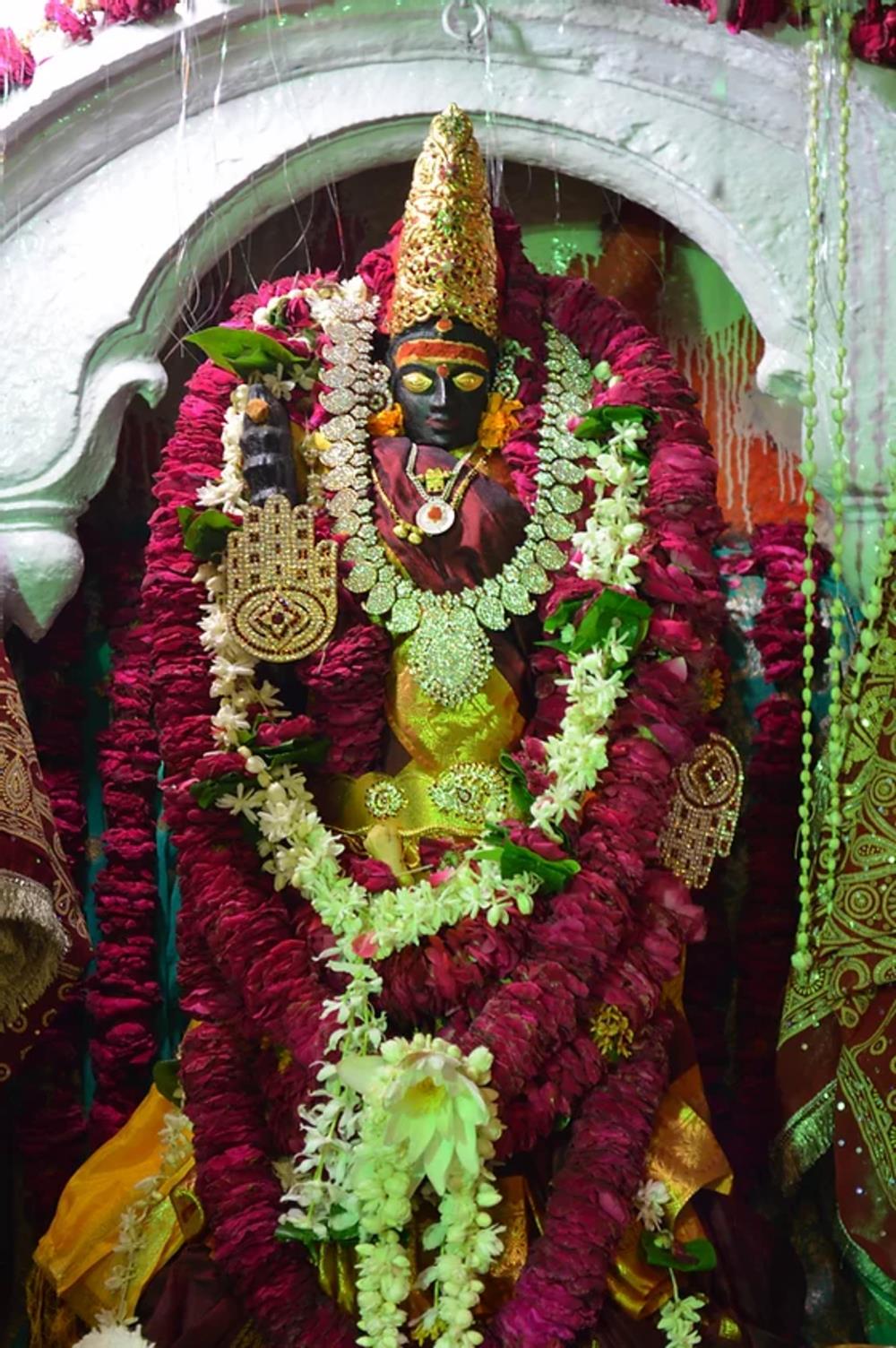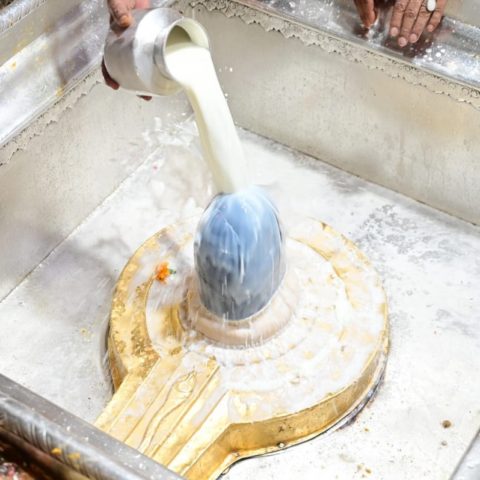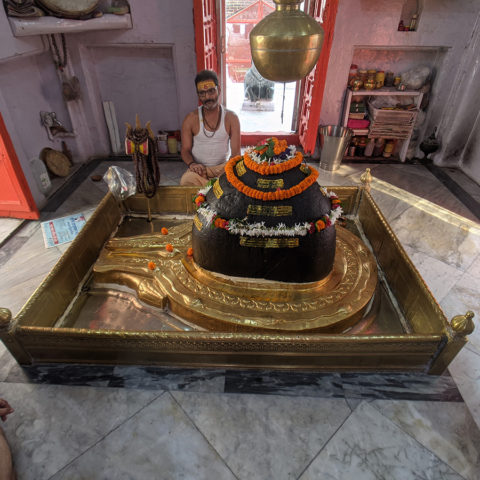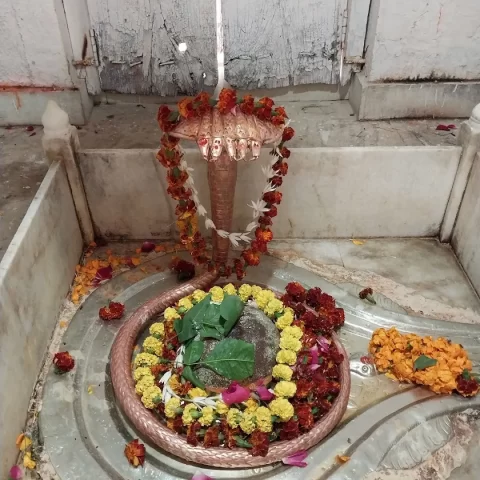
Vishalakshi Temple in Kashi is a Shaktipeetha dedicated to Parvathi Devi, the consort of Lord Shiva. Being one of the 51 Shaktipeethas, the eyes or earrings of Sati Devi fell here. Vishalakshi implies ‘wide eyes’. Hence, as per the name, the eyes may have fallen here. The Vishalakshi Temple finds its mentions in the must visit temples of Kashi as per the Skanda Purana. Devotees throng the Vishalakshi Temple through the narrow lanes of Kashi. The walk on the roads of Kashi itself is a thrilling devotional experience.
The temple is located in the Meer Ghat area of Kashi on the banks of the sacred Ganga. The Vishalakshi temple is also known as the Vishalakshi Gauri temple or Kashi Vishalakshi Shaktipeetha.
In fact, Vishalakshi Devi is known as the second consort of Lord Shiva in Kashi. She is considered as part of a triad i.e., Kanchi Kamakshi, Madurai Meenakshi and Kashi Vishalakshi.
The temple had witnessed the brunt of many invasions just like many other temples in Kashi. Adi Shankaracharya had visited this temple and devised ways to restore the powers of the Deity. He had installed a Sri Yantram in the temple which is worshipped even today. In fact Adi Guru Shankaracharya did the pratishthapana of another Deity in the temple.
The origin of Vishalakshi Temple
The lila of Sati Devi immolating herself in her own yogic-fire after the disrespect of her husband Lord Shiva as well as the cutting of her body into 51 parts by Sudarshana Chakra is documented in the Skanda Purana. There are portions pertaining to the Vishalakshi temple in the Devi Bhagavatam.
Sati Devi, who was the daughter of Daksha Prajapati was very devoted to Lord Shiva. She decided that she would marry no one except Lord Shiva and hence, undertook severe penances. Lord Shiva was pleased with Sati Devi’s sincere devotion to him and hence, married her. Daksha was against the marriage of his daughter with Lord Shiva, who walked about like a mendicant rubbed with ash all over his body and followed by the various bhuta ganas.
Hesitatingly, Daksha allowed the marriage to take place. He considered Lord Shiva to be a pauper even though Lord Shiva could make his devotees richer than the richest. Daksha never accepted the marriage of Sati Devi and Lord Shiva wholeheartedly.
Once, Daksha organized a huge sacrifice in which all the prominent citizens of the universe were invited. He did not invite Lord Shiva. Seeing the various denizens of the universe travelling with their partners in special airplanes towards her father’s grand sacrificial venue, Sati Devi became morose that her father didn’t invite them.
Though restraining herself for some time, she couldn’t bear it and so went to her husband. Lamenting over the situation, she expressed her desire to go to the venue of the sacrifice conducted by her father Daksha. She was desirous of seeing her family. Lord Shiva counselled Sati Devi that it was not wise to go to the sacrificial venue.
Sati Devi, who was afflicted with separation from her family, decided to go after pondering over her husband’s wise advice. She got ready and began her journey with a retinue of her assistants and the various bhuta ganas. On reaching the venue of the sacrifice, she observed that her father Daksha had made no arrangements to welcome her. Not even a seat of honour for her husband Lord Shiva, who is one of the respected Trimurtis.
Rather, Daksha abused Lord Shiva profusely. Sati Devi could not tolerate the harsh insult of her husband. After telling her father Daksha that she couldn’t tolerate this insult and that she would destroy the very body given by her father, she sat down in a yogic position and meditated strongly. She generated a yogic-fire from her body which consumed Sati Devi completely.
Most of the prominent citizens in the sacrificial venue were shocked by the course of events. There were many ill-omens like earthquake, clashing of swords, etc.
When Lord Shiva came to know of the events, a huge and powerful person called Virabhadra appeared from the depth of his anger. He was holding the great missile called Bhushundi. He ordered Virabhadra to go and punish Daksha along with those who came forward to help Daksha. Lord Shiva created hundreds of crores of ganas from his very breathing and ordered them to go towards Daksha’s sacrificial venue.
Many left off in front of Virabhadra while many followed Virabhadra by his side. The ganas who arrived before Virabhadra started destroying the entire venue by uprooting trees, sacrificial posts, destroying the mountain peaks, etc. Some ate up all the curds and ghee meant for the sacrifice. Many of the participants of the yagna had their various bodily parts disfigured by the ganas.
Soon, Virabhadra reached the venue and started fighting with Lord Vishnu after condemning all the participants. He was checked by Lord Vishnu numerous times. He disfigured and cut-off Daksha’s head. After Lord Shiva reached the venue, he picked up Sati Devi’s body and went about the universe in grief.
The entire universe started trembling due to the anger and grief of Lord Shiva. To maintain the normal functioning of the universe, Lord Vishnu sent his celebrated Sudarshana Chakra to cut Sati Devi’s body into many pieces. The devoted Sudarshana Chakra cut the body of Sati Devi into 51 parts. Each part fell at different points on earth and they came to be known as Shaktipeethas. Vishalakshi temple is one of those 51 Shaktipeethas.
Lord Shiva, later appointed Bhairavas to guard each Shaktipeetha.
Festivals at Vishalakshi Temple
Both the Navratris are celebrated grandly at the Vishalakshi Temple during the period of the waxing moon. One falls in the Hindu month of Ashwin (October) which leads up to Vijayadashami. The other Navratri falls in the Hindu month of Chaitra (March). Devotees visit this temple specifically on the fifth night of Navratri.
The annual Vishalakshi temple festival is celebrated on Kajali Teej, the third lunar day in the moon’s waning period of the month of Bhadrapada, the last month of the rainy season. Women observe this day for the welfare of their brothers and sing special songs called Kajali.
Temple Timings of the Vishalakshi Temple
The Deity of Vishalakshi Devi at this small shrine is very beautiful. With devotion, you will definitely feel satisfied with her darshan. One more Deity is present behind the main Deity. Some people say that it is the swayambhu (self-manifested) Deity of Devi. While others refute it.
The darshan timings and worship of the Vishalakshi temple are as follows:
Morning: 4.30 AM to 11.00 AM
Evening: 5.00 PM to 10.00 PM
Make sure you plan well in advance if you desire to witness a specific aarti or perform a special puja such as the kumkumarchana.
How to reach Kashi Vishalakshi Temple
Visiting the abode of Kashi Vishalakshi Devi is very special. One is that the Vishalakshi emple is one of the Shaktipeethas. The other is that it is located in Lord Shiva’s own city, Kashi. To reach her abode, you have reach Lord Shiva’s abode i.e., Kashi. In Kashi, you need the blessings of Kaal Bhairav and Dandapani before visiting the other temples.
So, plan your yatra to Kashi first with utmost devotion. If you are thinking of Tirtha Yatra, there is no better option than joining their Kashi Yatra or Ayodhya-Kashi Yatra.
If you’re thinking of other options, here are they:
By Road: Kashi is well connected by road to major cities in India such as New Delhi, Mumbai, Lucknow, etc. You can travel in a private vehicle from other cities or hire a taxi. Luxury buses and normal buses are available from Lucknow frequently.
By Rail: Kashi is very well connected to major cities and towns in India via the five railway stations i.e., Kashi Railway Station, Varanasi Junction (also called Varanasi Cantt), Varanasi City, Banaras Railway Station and Pt. Deen Dayal Upadhyaya Junction. Tickets can be reserved up-to any one of these five stations.
By Air: Kashi is accessible by air through the Lal Bahadur Shastri Airport at Babatpur near Kashi. Domestic and International flights are available from and to the airport. From there, you can take a prepaid taxi to reach the city centre.
0













Leave a Reply